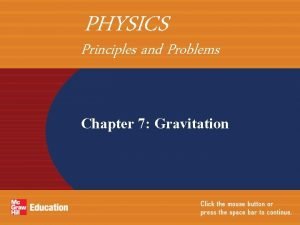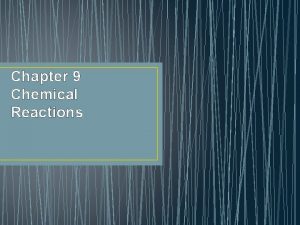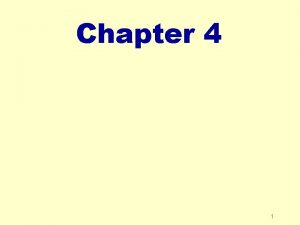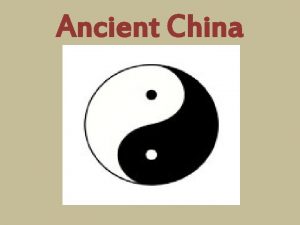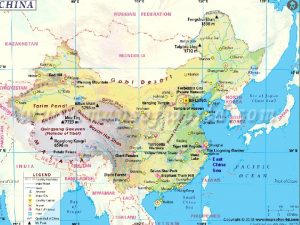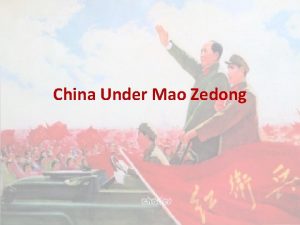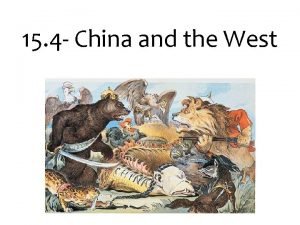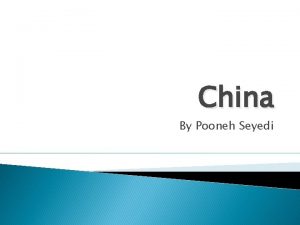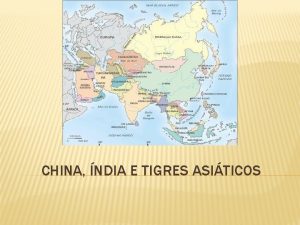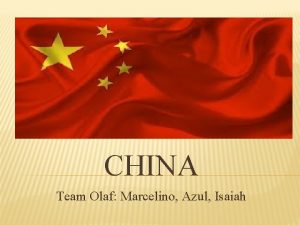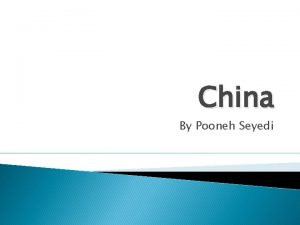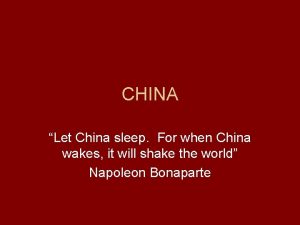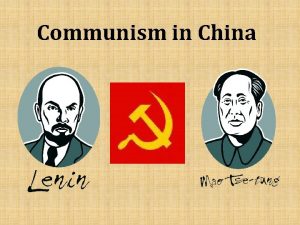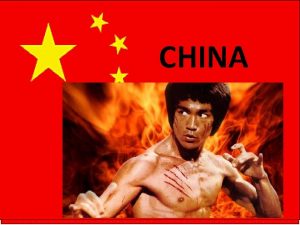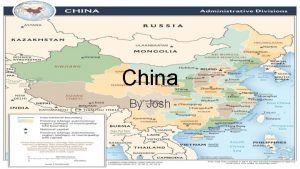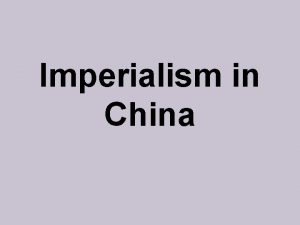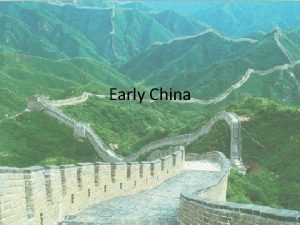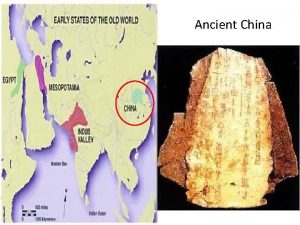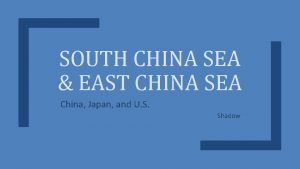Chapter Seven China Study Guide Chapter Seven Study


























- Slides: 26

Chapter Seven: China Study Guide

Chapter Seven: Study Guide 1. What was the Grand Canal? A canal linking northern China with Southern China

Chapter Seven: Study Guide 2. How was the Period of Disunion ended? In 589, Yang Jian conquered the south to unify China, and brought stability and order by establishing the Sui dynasty. 3. What happened to China following the collapse of the Han Dynasty? When the Han dynasty collapsed, China split into several rival kingdoms. This time of disorder is known as the Period of Disunion.

Chapter Seven: Study Guide 4. Place the Chinese dynasties – Sui, Tang, and Song – in the order in which they ruled. Sui dynasty, Tang dynasty, Song dynasty

Chapter Seven: Study Guide 5. Why is the Tang Dynasty viewed as a golden age of Chinese civilization? One of China’s greatest rulers, Taizong, conquered many lands, reformed the military, and created law codes. Later, many poets arose and the culture flourished.

Chapter Seven: Study Guide 6. Define cultural diffusion. The spread of an idea or philosophy from one culture or society to another. 7. Why did people turn to Buddhism during the Period of Disunion? People took comfort in the Buddhist teaching that people can escape suffering and achieve a state of peace.

Chapter Seven: Study Guide 8. What kind of ruler was Empress Wu? Empress Wu was the only woman to rule China after husband died. She ruled with an iron fist. Those who threatened her power risked death. She chose advisers based on their abilities rather than rank. She also gain support due to her dedication to Buddhism.

Chapter Seven: Study Guide 9. Where did Buddhism originate? Buddhism originated in India around 500 b. c. 10. What is the Buddhist way to peace called? (see notes) The Eightfold Path

Chapter Seven: Study Guide 11. What did the dragon backbone do for farmers? 12. What crops were grown in China? Allowed one farmer to do the work of several by scooping up water and pouring it into an irrigation canal. Wheat, barely, rice, other grains, cotton, and tea

Chapter Seven: Study Guide 13. How were agricultural surpluses related to the growth of cities? The extra food grown in the country could feed more people in the cities, which in turn grew larger

Chapter Seven: Study Guide 14. With a population of more than a million people, Chang’an was by far the largest city in the world at the time. 15. How were Chinese trade cities unique? They were a mix of people from many different and religions and were quite large in population.

Chapter Seven: Study Guide 16. How did the Grand Canal contribute to China’s internal trade? It connected major cities and allowed a large amount of goods and crops to be transported from agricultural areas to the cities.

Chapter Seven: Study Guide 17. What is porcelain? A thin, beautiful type of pottery 18. List the seven important Chinese inventions: Paper, porcelain, woodblock printing, gunpowder, movable type, magnetic compass, and paper money

Chapter Seven: Study Guide 19. What was gunpowder originally used for? 20. What were some of China’s exports? Fireworks Tea, rice, spices, jade, silk, and porcelain

Chapter Seven: Study Guide 21. Define ethics. Moral principles that guide proper behavior 22. What was the focus of the teaching Confucius? Ethics for individuals and the government

Chapter Seven: Study Guide 23. Why did Confucianism decline in popularity during the Period of Disunion? People turned to Buddhism for comfort during the troubled times of the Period of Disunion

Chapter Seven: Study Guide 24. How are Buddhism and Confucianism different? Buddhism – spiritual views Confucianism – ethical behavior

Chapter Seven: Study Guide 25. Define bureaucracy. A body of unelected government officials 26. What was Neo. Confucianism? It included spiritual matters similar to Buddhism and ethics. The emphasis on proper behavior would encourage people to obey their government

Chapter Seven: Study Guide 27. Who were scholarofficials? An educated member of China’s government who passed a series of written examinations. These people were well respected and admired. 28. What is civil service? Service as a government official.

Chapter Seven: Study Guide 29. Where did the Mongols originate? The plains of northern China 30. Define isolationism. The policy of avoiding contact with other countries.

Chapter Seven: Study Guide 31. Why was the period of the Yuan dynasty a significant time in China’s history? It was the first time China was ruled by foreigners 32. What effect might Marco Polo’s description of life in China have on European traders? Other European traders may have wanted to go to China to trade

Chapter Seven: Study Guide 33. What led to the downfall of the Yuan Dynasty? Failed campaigns against Japan, expensive public-works projects that weakened the economy, and Chinese resentment, all of which led to rebellions.

Chapter Seven: Study Guide 34. Where did the expeditions of Zheng He travel? Throughout the Indian Ocean and as far west as the Persian Gulf, and the easternmost coast of Africa. 35. What is the Forbidden City? A huge complex of almost 1, 000 buildings in the heart of China’s capital. These buildings included imperial residences, temples, and other government structures.

Chapter Seven: Study Guide 36. What was the job of a Chinese censor? To investigate and report on local officials and local institutions 37. How were the Ming emperors more powerful than those of the Tang and Song? They abolished the offices of powerful officials, took a larger role in running the government, and punished anyone who challenged them.

Chapter Seven: Study Guide 38. How may the Great Wall have both hurt and helped China? The wall protected China but it was very costly to build 39. How did the Mongols gain control of China? By attacking and terrorizing Chinese towns

Chapter Seven: Study Guide 40. What were the differences between Genghis Khan and Kublai Khan? Genghis Khan was a brutal and unforgiving leader, while Kublai Khan urged his generals to be humane in their conquests. He wanted to run an effective government and encouraged religious tolerance.
 The seven heavenly virtues mal
The seven heavenly virtues mal Sexual reproduction in paramecia is called _____.
Sexual reproduction in paramecia is called _____. Chapter 7 study guide gravitation
Chapter 7 study guide gravitation Chapter 6 study guide motion in two dimensions
Chapter 6 study guide motion in two dimensions Chapter 12 thermal energy study guide answers
Chapter 12 thermal energy study guide answers Chapter 11 study guide conservation of energy
Chapter 11 study guide conservation of energy Chapter 15 earth's oceans study guide answer key
Chapter 15 earth's oceans study guide answer key Chapter 12 test geometry
Chapter 12 test geometry Main idea youtube
Main idea youtube Chapter 19 review oxidation-reduction reactions
Chapter 19 review oxidation-reduction reactions Chapter 12 states of matter
Chapter 12 states of matter Stoichiometry chapter 11 study guide
Stoichiometry chapter 11 study guide Chapter 10 chemistry study guide
Chapter 10 chemistry study guide Chapter 9 study guide chemical reactions
Chapter 9 study guide chemical reactions Chapter 8 study guide human resources culture and diversity
Chapter 8 study guide human resources culture and diversity Chapter 8 human resources culture and diversity
Chapter 8 human resources culture and diversity Chapter 5 biodiversity and conservation test answer key
Chapter 5 biodiversity and conservation test answer key Study guide section 1 population dynamics
Study guide section 1 population dynamics Chapter 4 accounting study guide
Chapter 4 accounting study guide Chapter 35 section 1 the digestive system
Chapter 35 section 1 the digestive system Study guide chapter 31 section 1 basic behaviors
Study guide chapter 31 section 1 basic behaviors Chapter 29 reptiles and birds worksheet answer key
Chapter 29 reptiles and birds worksheet answer key Chapter 28 section 1 fishes study guide answer key
Chapter 28 section 1 fishes study guide answer key Chapter 27 quantum theory study guide answers
Chapter 27 quantum theory study guide answers Chapter 23 series and parallel circuits study guide answers
Chapter 23 series and parallel circuits study guide answers Chapter 18 section 2 viruses and prions
Chapter 18 section 2 viruses and prions Chapter 16 primate evolution assessment answer key
Chapter 16 primate evolution assessment answer key


